[Editor’s note: This article was first published in 2005 and has been modified to meet MyCG style. Marvin Perrett passed away in 2007. In recognition of his World War II service, he received numerous ribbons for naval campaigns in the European and Pacific theatres, as well as induction into the French Legion of Honor with rank of Chevalier. Perrett was also a recipient of the Coast Guard’s Distinguished Public Service Award, the Pentagon’s Spirit of Hope Award, and he will be honored as namesake of a Fast Response Cutter.]
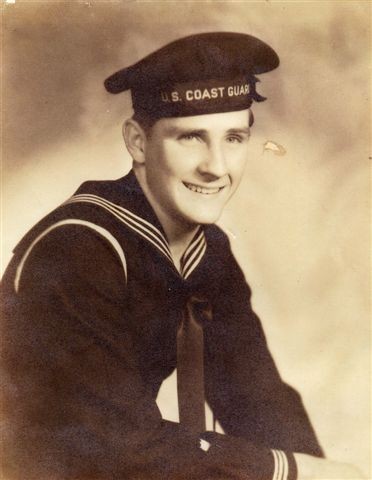 From delivering troops to the beaches of Normandy and Okinawa, to witnessing the raising of the American flag on Mount Suribachi in Iwo Jima, Marvin Perrett shared his life’s story with America on his role as a Coast Guard Higgins boat landing craft, vehicle, personnel (LCVP) coxswain.
From delivering troops to the beaches of Normandy and Okinawa, to witnessing the raising of the American flag on Mount Suribachi in Iwo Jima, Marvin Perrett shared his life’s story with America on his role as a Coast Guard Higgins boat landing craft, vehicle, personnel (LCVP) coxswain.
An advocate for educating America on the Coast Guard’s role in World War II, Perrett has been featured on CNN Headline News, “Oliver North’s War Stories,” and The History Channel’s “Mail Call with R. Lee Ermey.” Despite his national recognition, his greatest joy came from sharing his story with children.
“Like most veterans, I never told anyone my story,” Perrett said. “Over the years, I began to realize that someone had to talk about their experience because the children in our schools need to hear the story of their country firsthand.”
Ronald Abboud, a dear friend of Perrett and volunteer at the National D-Day Museum (now the National World War II Museum) in New Orleans said, “It’s rare to find World War II veterans who speak out about their role in the war, and Marvin is the exception.”
Traveling the country in his 10-passenger conversion van, complete with satellite radio, television and a convertible bed, Perrett spends his days traveling to schools and talking to groups of children. Carrying a suite of war memorabilia, Perrett presents with the energy and exuberance typically found in the children he teaches. To top it off, he does it all while dressed in the World War II-era uniform; he is rarely seen without it. He even shops for groceries and does housework in uniform.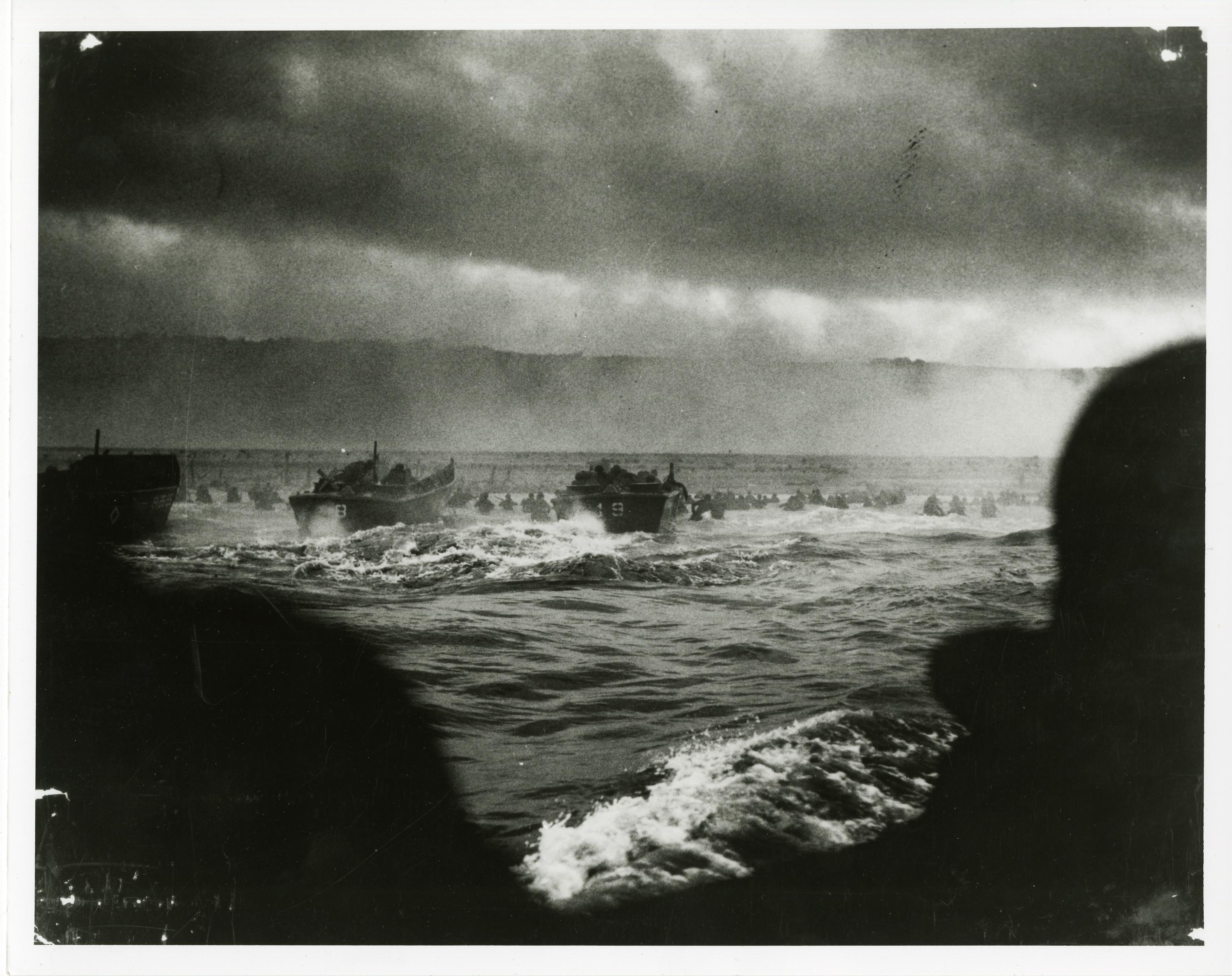
Fortunately, Perrett’s work has not gone unnoticed. On Oct. 10, 2005, the New Orleans Chapter of the Coast Guard Chief Petty Officer Association, on behalf of the Hampton Roads, Virginia, chapter, appointed Perrett an honorary chief, an advancement from Boatswains Mate 2nd Class. Additionally, Perrett attended the 60th anniversary D-Day invasion commemoration ceremony in Normandy, as a guest of then-French Consul General Patrick Rolot. There, Perrett was awarded a Knight of the Legion of Honor medal, France’s most prestigious award for feats of military valor. Of the 100 recipients, Perrett was one of just two Coast Guardsmen to receive the coveted award.
More recently, Perrett received a Coast Guard Distinguished Public Service Award Nov. 16, 2005, the highest honor the Coast Guard can bestow upon a civilian.
“I was in Pittsburgh visiting schools and lecturing students on my military service,” Perrett said. “When I had finished my business, I went to Coast Guard Marine Safety Office Pittsburgh to address the commanders and their unit. When I arrived, Rear Adm. Robert Duncan from the 8th Coast Guard District and Rear Adm. Joel Whitehead from Coast Guard Headquarters emerged from closed doors and bestowed upon me the award, which I cherish dearly.”
“Marvin Perrett is truly a national treasure,” said Duncan, commander of the 8th Coast Guard District. “Aside from being a part of the Coast Guard’s greatest generation, he has continued to shine as an example, to today’s generation and to th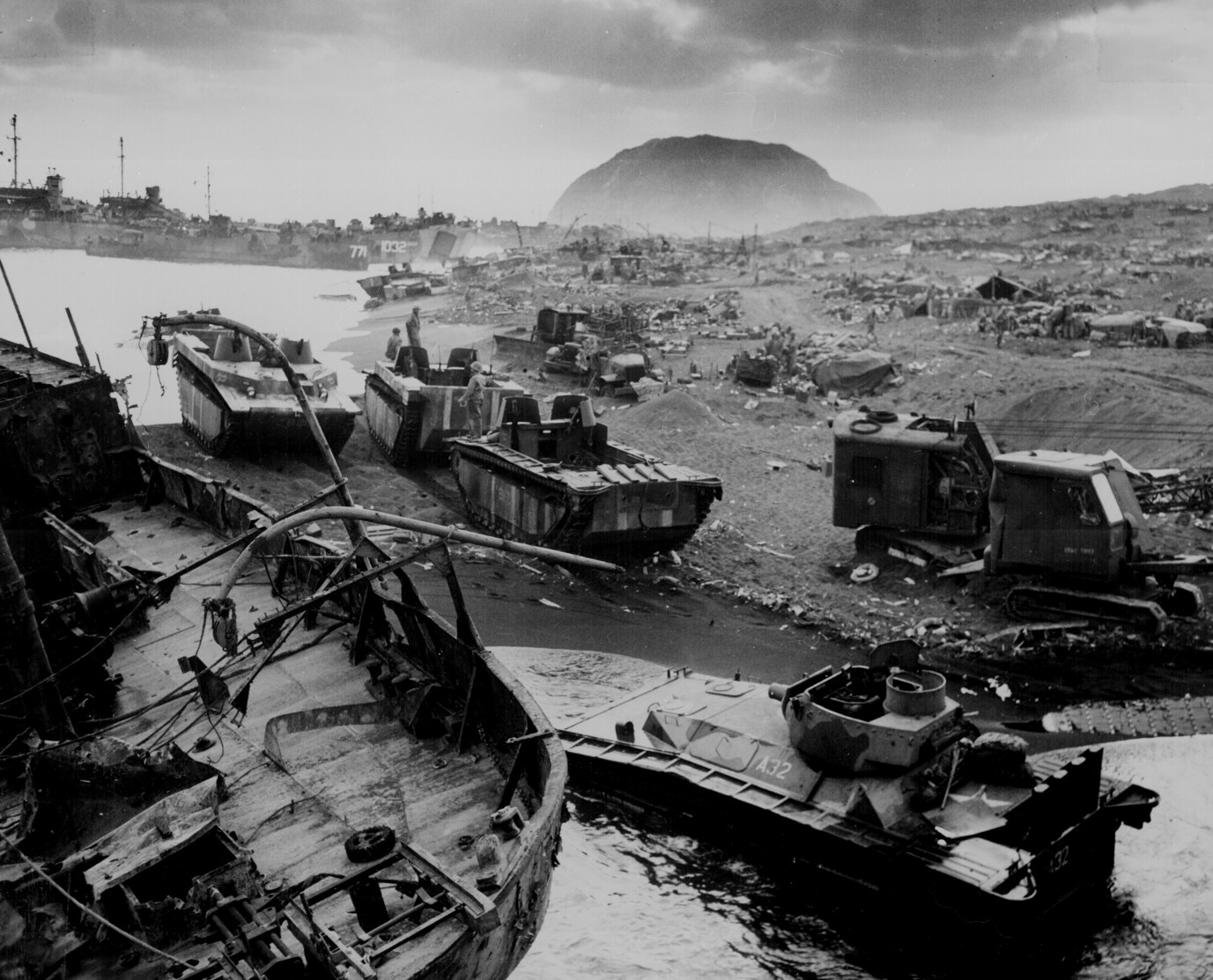 e youth of our nation, on what sacrifice, dedication and true heroism really mean. He has been an inspiration to us all.”
e youth of our nation, on what sacrifice, dedication and true heroism really mean. He has been an inspiration to us all.”
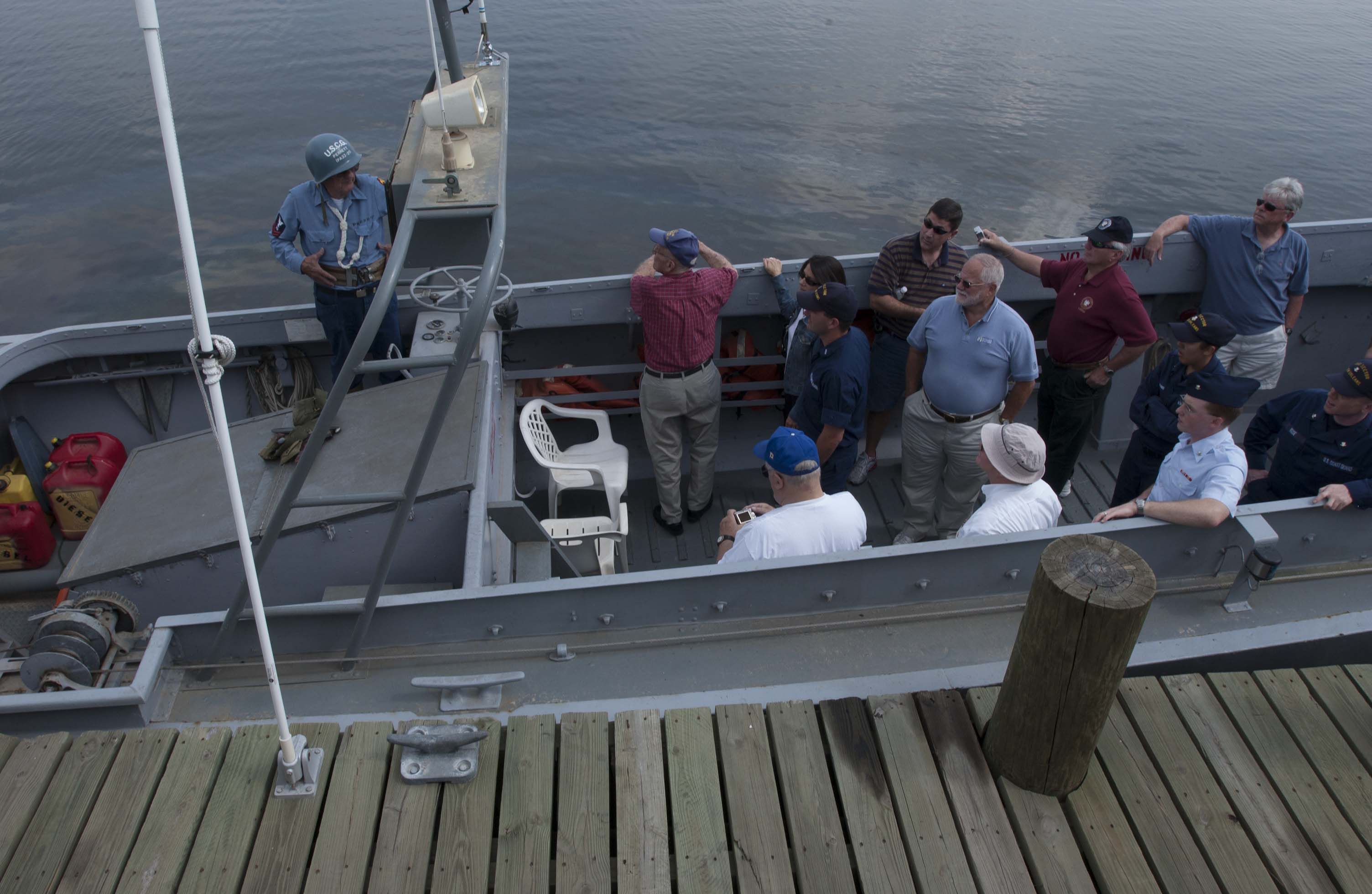 On an early Saturday morning in July 2004, Perrett stood in the lobby of a Metairie, Louisiana, Holiday Inn awaiting the arrival of a Texas-based ABC network film crew producing a documentary on World War II veterans. Seizing the opportunity, as he so often did, Perrett took the time to give a brief synopsis of his life to the desk clerk. All the while, a group of high school cheerleaders gathered in the lobby. Without hesitation, Perrett excused himself from the desk clerk and approached the young women with his duffel bag in tow. He reached into his bag and pulls out a stack of flyers illustrating his story in brief. Handing them out to the cheerleaders, he began the story he has told to so many before.
On an early Saturday morning in July 2004, Perrett stood in the lobby of a Metairie, Louisiana, Holiday Inn awaiting the arrival of a Texas-based ABC network film crew producing a documentary on World War II veterans. Seizing the opportunity, as he so often did, Perrett took the time to give a brief synopsis of his life to the desk clerk. All the while, a group of high school cheerleaders gathered in the lobby. Without hesitation, Perrett excused himself from the desk clerk and approached the young women with his duffel bag in tow. He reached into his bag and pulls out a stack of flyers illustrating his story in brief. Handing them out to the cheerleaders, he began the story he has told to so many before.
Perrett was born Sep. 17, 1925, in New Orleans, and was the adopted son of J.N. and Alice Perrett, brother of J.N., Jr., and Judy, and father to Melissa.
“I was just 17 years old when I dropped out of Warren Easton High School and presented myself to the Navy recruiter in New Orleans,” said Perrett. “I was turned away because the recruiter stated they had already met their quota for the day; however, the recruiter suggested I try joining the Coast Guard. Like most people, I didn’t know what the Coast Guard was, but I felt the need to answer the call of service as so many people did at the time. I arrived at the Coast Guard recruiting office at 146 Barrone Street in New Orleans at 9 a.m. They processed me all day, and at 5 p.m., one day before my 18th birthday, I was told to raise my right hand and was sworn in as the newest member of the Coast Guard.”
Growing up in the New Orleans 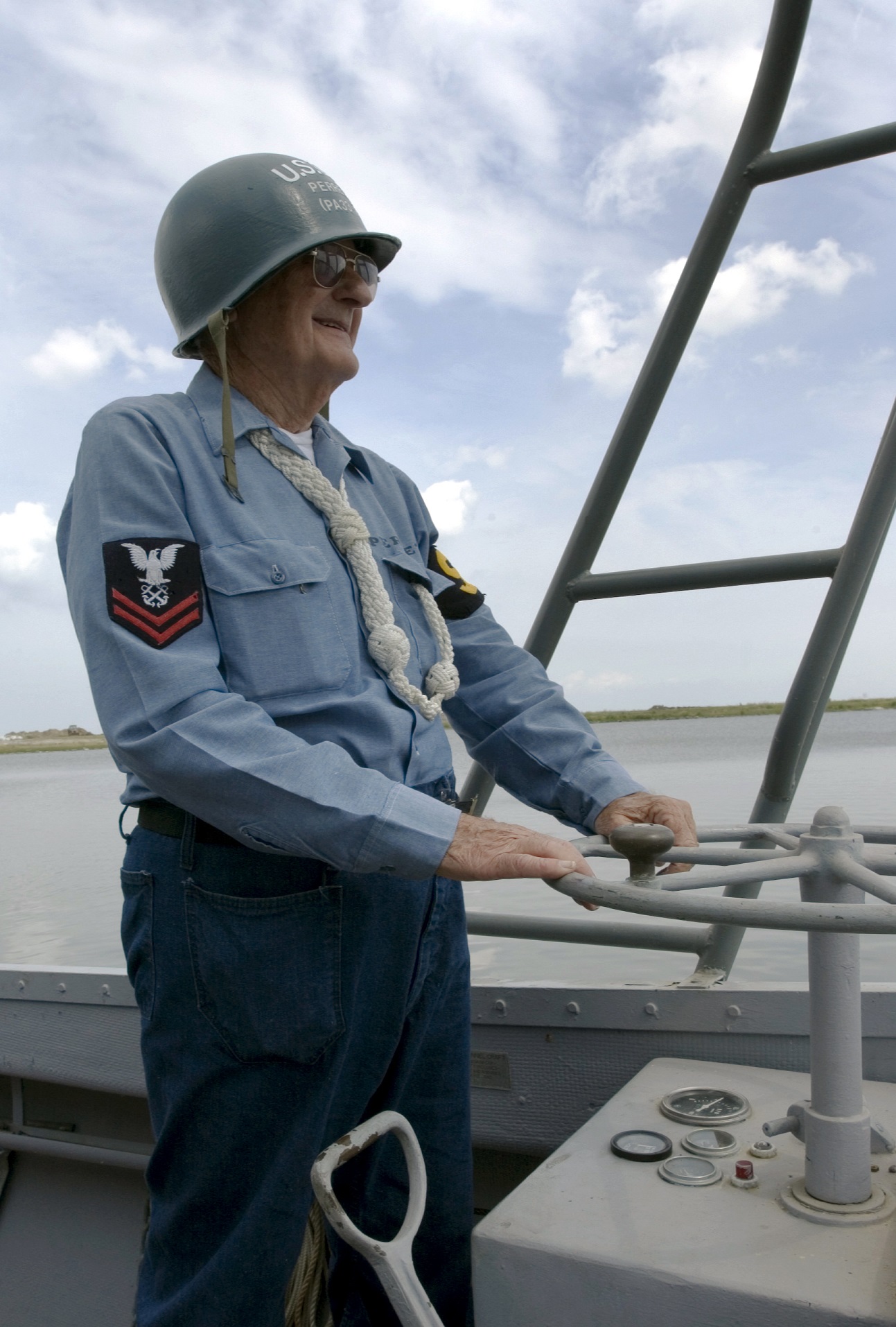 area, Perrett was well aware of Higgins Industries Inc., a boat manufacturer that produced 8,865 landing craft, approximately 92 percent of the Navy’s World War II combat motorboat fleet, according to HigginsBoat.org.
area, Perrett was well aware of Higgins Industries Inc., a boat manufacturer that produced 8,865 landing craft, approximately 92 percent of the Navy’s World War II combat motorboat fleet, according to HigginsBoat.org.
“As a child living near Lake Pontchartrain, I would witness Higgins landing craft full of troops and sailors simulating assault landings on the beach,” Perrett recalls. “I thought, ‘Boy that looks pretty dangerous, I don’t want any part of that.’ Wouldn’t that just be my dumb luck—that was the exact assignment I received.”
After enlisting in the Coast Guard and receiving his assignment, Perrett was sent to St. Augustine, Florida, where he spent six rigorous weeks in boot camp. “Toward the end of our training, 150 of us were taken to Camp Lejeune, North Carolina,” Perrett recalled. “Once in North Carolina, we trained with the Marines. As Coast Guardsmen, we were trained to drive the Higgins boats, and the Marines were trained to storm the beach. It was a great example of two services coming together to learn from one another.”
After completing boot camp and advanced landing craft training, Perrett became a certified Higgins LCVP coxswain and was transferred to Norfolk, Virginia, where he reported aboard the USS Bayfield, a Coast Guard-manned Navy troopship.
“Once aboard the Bayfield, we traveled through Chesapeake Bay, Maryland, and continued our training—storming the beaches of Maryland,” Perrett said. “After six weeks, in February 1944, we were on our way to our first foreign port—Glasgow, Scotland.”
“When we arrived in Glasgow,” Perrett said, “we continued to train—nighttime, daytime, fair weather, foul weather, it didn’t matter. We knew we were going to invade France, but we didn’t know where in France or when we were going.”
At 9 a.m. on June 5, 1944, the Bayfield departed Plymouth for Normandy. Perrett recalled the infamous trip, which took him from a safe English port and challenged everything he thought he knew.
“As we traveled along the coast of England, passing coastal ports, ships would set sail and join the parade,” Perrett stated. “After 150 miles, the Bayfield was one of more than 5,000 ships en route to Normandy. That single event was the largest gathering of ships in history.”
After traveling more than 17 hours, the Bayfield arrived approximately 12 miles offshore from Utah Beach, just outside the range of enemy gunfire.
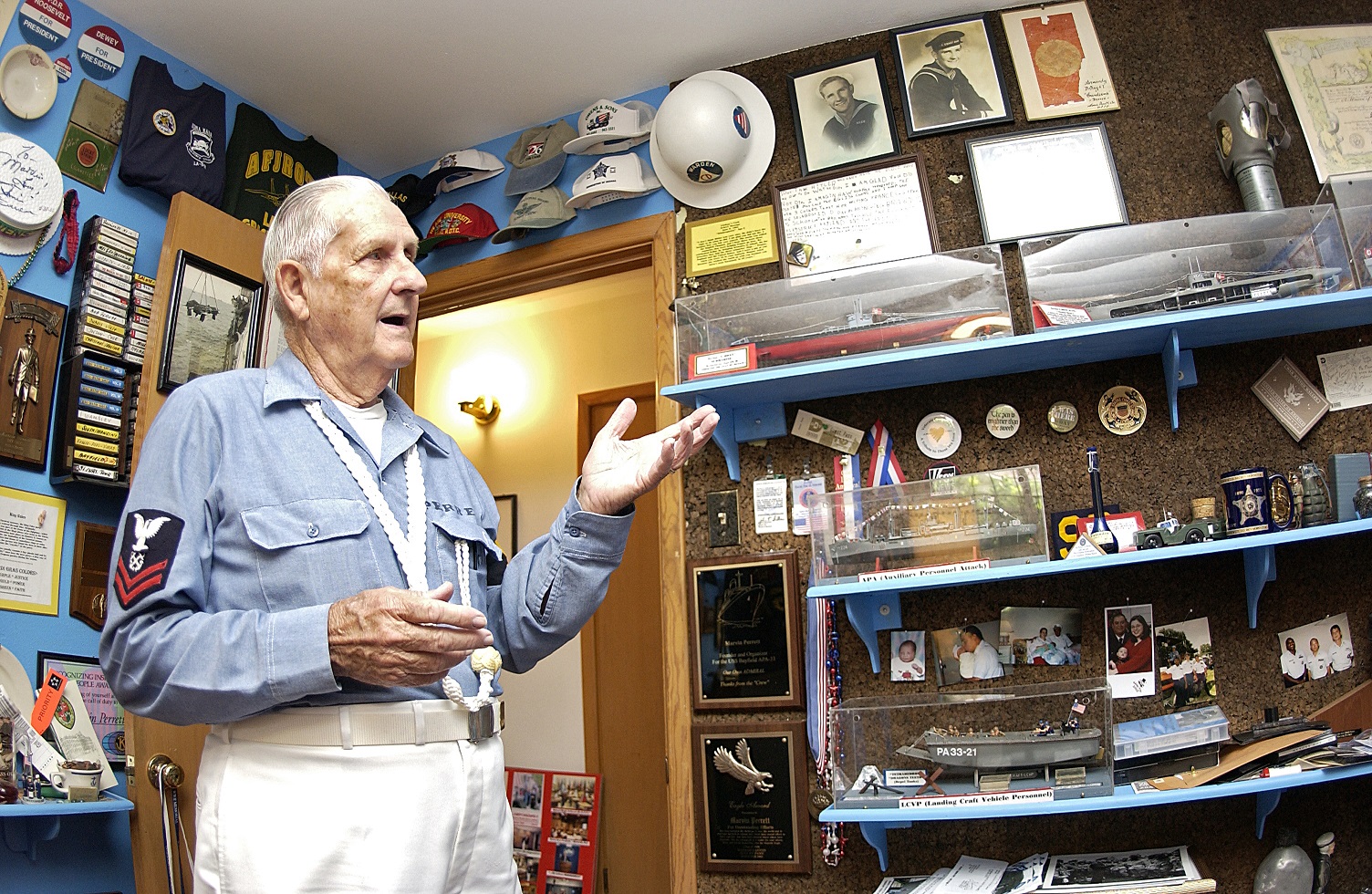 “At 2:30 in the morning on D-Day, we received the call to weigh our boats, which meant it was time to put the landing craft into the water,” Perrett recalls. “Once in the water, 36 assault troops boarded my boat and we started circling the waters with about 10 to 12 other boats in complete darkness.”
“At 2:30 in the morning on D-Day, we received the call to weigh our boats, which meant it was time to put the landing craft into the water,” Perrett recalls. “Once in the water, 36 assault troops boarded my boat and we started circling the waters with about 10 to 12 other boats in complete darkness.”
“After some time had passed and for whatever reason, I looked around and found all 36 men were looking straight at me, staring me down. I asked them what was wrong, and a gentleman spoke up and stated that in a training scenario the day before, the coxswain dropped them off in about four feet of water. They didn’t want the same thing to happen now that they were in combat. After looking at his machine gun, I assured him that I would do my best to see that it didn’t happen again.”
“Despite my ill attempts to reassure them, they continued to stare me down. At that point, I looked at this Army lieutenant who looked as white as a sheet. After realizing that we had been sucking up diesel fumes and circling for several hours, it dawned on me that he was seasick. Not knowing windward from leeward, he went off to the side of the boat to do his business, but the wind caught it and put it all on my face. I was wearing it all—bacon, eggs, coffee, milk, you name it, I was wearing it.”
“My motormack [motor machinist’s mate] saw what happened and quickly scooped up a bucket of seawater and shouted for me to close my eyes. I told him that my eyes were already closed, that’s what the problem was. Just then a quick rush of cold seawater hit me, and it washed all the food into my shirt.”
“My motormack asked me if I wanted another bucket, I replied, ‘Sure do, that was some strong medicine.’ Then I was hit with another bucket of cold seawater. Everyone on the boat started laughing, which broke the awkward silence of battle, if even for a minute. After that incident, the general consensus on the boat was, ‘If he can handle that, then I guess we’re alright.’”
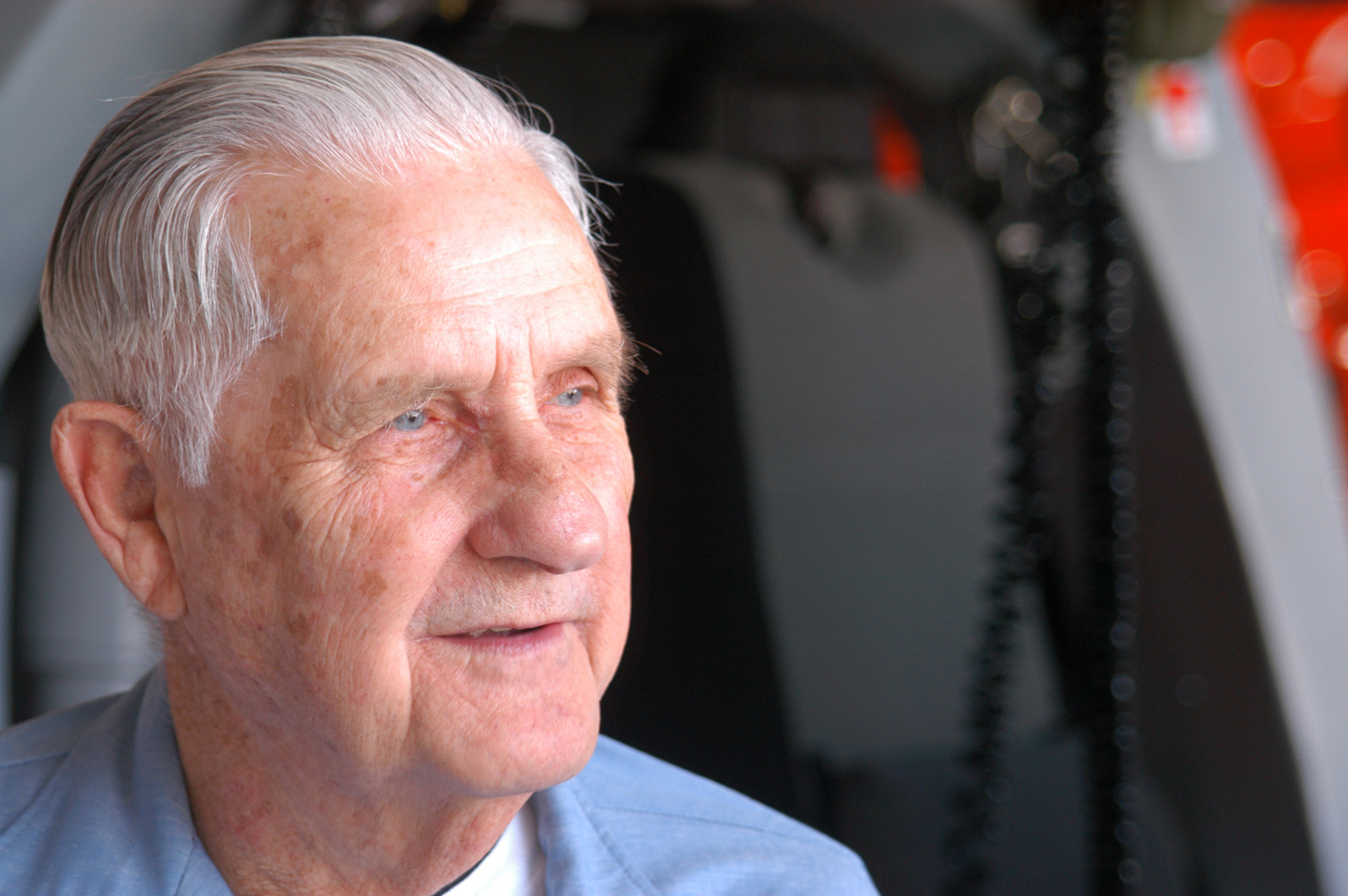 After the invasion of Normandy, Perrett participated in the invasions of southern France, Okinawa, and Iwo Jima.
After the invasion of Normandy, Perrett participated in the invasions of southern France, Okinawa, and Iwo Jima.
On Feb. 19, 1945, Perrett nearly lost his life, but instead, he lost his boat while trying to save the life of a U.S. Marine. “In Iwo Jima, I carried 36 Marines to shore and dropped them off on the front lines,” Perrett recalls. “One Marine, who was carrying a heavy and awkward machine gun tripod, tripped and fell close to my lowered ramp. In order to prevent injury to the Marine, I put my boat into reverse to avoid hitting him. Waves started coming over the back of my boat and water started to collect in the bilge pumps. Once I was far enough away from the Marine, I put the boat into neutral, which caused all the water in the boat to move forward. Before I could do anything, a wave came over the front of the boat and down she went.”
Luckily for Perrett, a Navy boat crew witnessed the accident and came to Perrett’s aid. Days later, he received a new boat and continued with his assignments.
“There was always a fear of losing my life, but I had it made up in my mind that I was coming back home,” Perrett stated.
At the conclusion of his story, the ABC film crew Perrett had been waiting for finally arrived at the hotel lobby. Perrett bade his farewell to the cheerleaders and escorted the film crew to a remote boat marina where he treated them to a special event—a ride on a Vietnam War-era landing craft, a replica of the boat Perrett piloted in World War II. Navigating the waters of Louisiana with great ease and comfort, Perrett turned to the film crew, shrugged his shoulders and stated, “I haven’t lost my touch.”